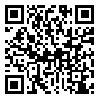Volume 13, Issue 2 (Paramedical Sciences and Military Health (Summer 2018) 2018)
Paramedical Sciences and Military Health 2018, 13(2): 28-33 |
Back to browse issues page
Download citation:
BibTeX | RIS | EndNote | Medlars | ProCite | Reference Manager | RefWorks
Send citation to:



BibTeX | RIS | EndNote | Medlars | ProCite | Reference Manager | RefWorks
Send citation to:
EivazZadeh N, Salimi Y, Deevband M, Jamshidi M, Mokri M. Evaluation of the Effective Dose from Transmission Scan in Whole Body Bone Scan with SPECT-CT in Shariati Hospital. Paramedical Sciences and Military Health 2018; 13 (2) :28-33
URL: http://jps.ajaums.ac.ir/article-1-134-en.html
URL: http://jps.ajaums.ac.ir/article-1-134-en.html
Nazilla EivazZadeh1 
 , Yazdan Salimi *2
, Yazdan Salimi *2 
 , MohammadReza Deevband3
, MohammadReza Deevband3 
 , MohammadHosein Jamshidi4
, MohammadHosein Jamshidi4 
 , Mersedeh Mokri5
, Mersedeh Mokri5 


 , Yazdan Salimi *2
, Yazdan Salimi *2 
 , MohammadReza Deevband3
, MohammadReza Deevband3 
 , MohammadHosein Jamshidi4
, MohammadHosein Jamshidi4 
 , Mersedeh Mokri5
, Mersedeh Mokri5 

1- Department of Radiology, Faculty of Para Medicine, AJA University of Medical Sciences, Tehran, Iran
2- Department of Medical Physics and Biomedical Engineering, Faculty of Medicine, Shahid-Beheshti University of Medical Sciences, Tehran, Iran ,salimiyazdan@gmail.com
3- Department of Radiology, Faculty of Para Medicine, Jondishapoor University of Medical Sciences, Ahvaz, Iran
4- Department of Radiology, Faculty of Para Medicine, Tehran University of Medical Sciences, Tehran, Iran
5- Department of Nuclear Medicine and Molecular Imaging, Shariati Hospital, Tehran University of Medical Sciences, Tehran, Iran
2- Department of Medical Physics and Biomedical Engineering, Faculty of Medicine, Shahid-Beheshti University of Medical Sciences, Tehran, Iran ,
3- Department of Radiology, Faculty of Para Medicine, Jondishapoor University of Medical Sciences, Ahvaz, Iran
4- Department of Radiology, Faculty of Para Medicine, Tehran University of Medical Sciences, Tehran, Iran
5- Department of Nuclear Medicine and Molecular Imaging, Shariati Hospital, Tehran University of Medical Sciences, Tehran, Iran
Abstract: (5600 Views)
Introduction: whole body bone scan is one of the most useful procedures of nuclear medicine. Accurate distribution of radiopharmaceutical is yielded by using SPECT-CT. There are concerns about the radiation dose of CT part. The present study aimed to evaluate the patients’ dose in bone nuclear medicine imaging.
Methods and Materials: First of all, the dose report of CT console was calibrated using CT head and body phantom. Then, imaging and personal data of 70 adult patients were collected. The software of Impact-Dose and MIRD were used to calculate the effective dose (ED) of CT and radiopharmaceutical respectively. CT dose were reported in terms of volume CT Dose index (CTDIvol), dose length product (DLP), and ED.
Results: Patients doses were 2.02 mGy, 93.5 mGy.cm and 1.33 mSv in terms of CTDIvol, DLP, and ED respectively. The 3rd quartile was 3.01 mGy, 150 mGy.cm and 2.18 mSv. The highest dose was seen in multi-regional scan fields and the lowest was in head region.
Discussion and Conclusion: The CT dose was considerable compared to the 99TC-MDP dose. Variations in received dose were caused by patient size and scan range. It is essential to increase the cares about the rules of optimization and justification for bone SPECT-CT.
Methods and Materials: First of all, the dose report of CT console was calibrated using CT head and body phantom. Then, imaging and personal data of 70 adult patients were collected. The software of Impact-Dose and MIRD were used to calculate the effective dose (ED) of CT and radiopharmaceutical respectively. CT dose were reported in terms of volume CT Dose index (CTDIvol), dose length product (DLP), and ED.
Results: Patients doses were 2.02 mGy, 93.5 mGy.cm and 1.33 mSv in terms of CTDIvol, DLP, and ED respectively. The 3rd quartile was 3.01 mGy, 150 mGy.cm and 2.18 mSv. The highest dose was seen in multi-regional scan fields and the lowest was in head region.
Discussion and Conclusion: The CT dose was considerable compared to the 99TC-MDP dose. Variations in received dose were caused by patient size and scan range. It is essential to increase the cares about the rules of optimization and justification for bone SPECT-CT.
Type of Study: Research |
Subject:
full articles
Received: 2018/03/3 | Accepted: 2018/08/13 | Published: 2018/09/21
Received: 2018/03/3 | Accepted: 2018/08/13 | Published: 2018/09/21
Send email to the article author
| Rights and permissions | |
 |
This work is licensed under a Creative Commons Attribution-NonCommercial 4.0 International License. |


